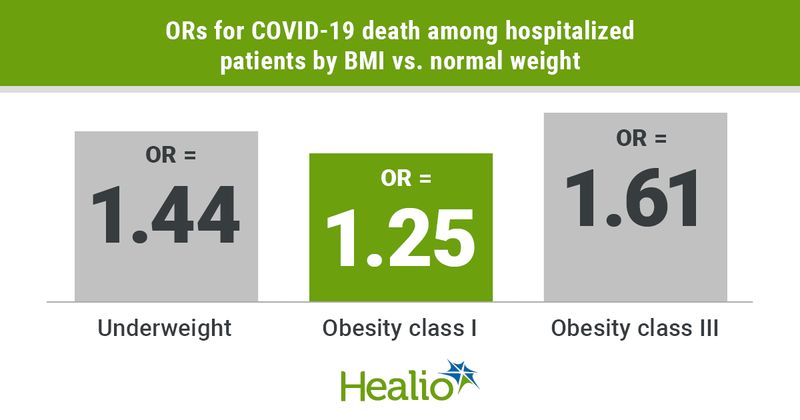Obesity increases odds for mechanical ventilation, mortality in COVID-19
Adults with obesity admitted to 12 New York hospitals with COVID-19 had higher odds for invasive mechanical ventilation and mortality when compared with those with a normal BMI, according to a study published in Obesity.

“Understanding disease processes and risk factors associated with COVD-19 are vital to improving patient and population health,” Tara S. Kim, MD, director of quality and weight management programs in the division of endocrinology at Lenox Hill Hospital and assistant professor at the Donald and Barbara Zucker School of Medicine at Hofstra/Northwell, and Eun Ji Kim, MD, MS, an assistant professor in the division of general internal medicine at the Donald and Barbara Zucker School of Medicine at Hofstra/Northwell, told Healio. “Our study finds that patients who are underweight (BMI < 18.5 kg/m2), obesity class II (35-39.9 kg/m2), and obesity class III ( 40 kg/m2) are associated with increased odds for death in COVID-19. In terms of being on mechanical ventilation, COVID-19 patients with obesity class I (BMI 30-34.9 kg/m2), class II and class III are associated with increased odds of being on mechanical ventilation. Once intubated, patients with obesity had the same odds of death, which suggests that pulmonary complication leads to poor outcome among patients with obesity.”

Tara S. Kim, Eun Ji Kim and colleagues analyzed electronic health record data for 10,861 adults (median age, 65 years; 59.6% men; 33.8% white) admitted to 12 Northwell Health system hospitals in New York with COVID-19 between March 1 and April 27. BMI was self-reported or obtained by the nursing staff at admission, with all participants categorized as underweight with a BMI of less than 18.5 kg/m2, normal weight with a BMI between 18.5 kg/m2 and 24.9 kg/m2, overweight with a BMI between 25 kg/m2 and 29.9 kg/m2, obesity class I with a BMI between 30 kg/m2 and 34.9 kg/m2, obesity class II with a BMI between 35 kg/m2 and 39.9 kg/m2, and obesity class III with a BMI of 40 kg/m2 or greater. Historical data and linear regression were used to estimate BMI for those who did not have one recorded. Researchers looked at the number of adults in each subgroup who were on invasive mechanical ventilation or died during hospitalization. Participants were followed through May 12.
Of the total study population, 37.7% had obesity, 37% had overweight, 23.1% had normal weight and 2.2% had underweight. Invasive mechanical ventilation was needed in 20.4% of participants and 23.9% died of COVID-19 complications.
Mechanical ventilation and mortality rates varied in each of the six BMI categories. After adjusting for covariates, adults in the overweight (adjusted OR = 1.27; 95% CI, 1.11-1.46) obesity class I (aOR = 1.48; 95% CI, 1.27-1.72) obesity class II (aOR = 1.89; 95% CI, 1.56-2.28) and obesity class III groups (aOR = 2.31; 95% CI, 1.88-2.85) had a greater likelihood for invasive mechanical ventilation. Men, adults aged 60 to 70 years, and those with Hispanic and Asian ethnicities had significantly higher odds for invasive mechanical ventilation.
Individuals in the underweight (aOR = 1.44; 95% CI, 1.08-1.92), obesity class II (aOR = 1.25; 95% CI, 1.03-1.52) and obesity class III groups (aOR = 1.61; 95% CI, 1.3-2) had increased odds of COVID-19 death. However, among those who needed invasive mechanical ventilation, underweight and obesity class III were not associated with increased odds of death.
Tara S. Kim and Eun Ji Kim said the findings reconfirm why there is an urgent need for providers to address obesity as a disease and growing epidemic.
“Our study findings bring to the forefront the need to recognize obesity as a disease process with short- and long-term health implications,” they said. “Weight management should be addressed at all health care visits with up-to-date documentation of weight and height. From a public health perspective, equitable access to health care, healthy foods and exercise resources must be addressed.”
For more information:
Eun Ji Kim, MD, MS, can be reached at ekim7@northwell.edu.
Tara S. Kim, MD, can be reached at tkim1@northwell.edu.

